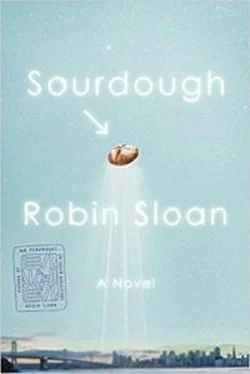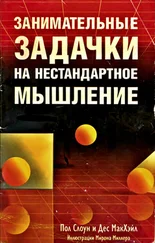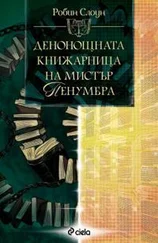“Peter!” Andrei boomed. “And Lois!” He looked around the table. “Do you all know Peter and Lois? Peter runs Control, and Lois works on Proprioception. Very cool stuff.”
Andrei knew everyone’s name and role. Everyone’s. It was said he used flash cards.
Peter and I had planned to begin with three to five minutes of small talk before easing into our overture, but looking at the group of Dextrous we had joined, I understood suddenly that everyone at the table had exactly the same plan. We were not the only birds of prey in this cafeteria.
“ The eggs! ” I blurted.
Andrei raised an eyebrow.
“I want to solve the egg problem,” I said. “I mean. Cooking. Specifically, baking.”
Andrei lifted a curl of fennel from the top of his salad and popped it into his mouth, where he chewed it thoughtfully.
Peter daintily removed the seal from his Tetra Pak.
The other Dextrous glowered.
“We’ve been working on that for a long time,” Andrei said.
“Right. But I know the Control codebase, and I know the task.”
“An integrated approach,” Peter interjected.
I nodded. We had practiced. “Task and Control together.”
Peter couldn’t help himself. “But if it works, Control gets the credit.”
We had the rest of the argument ready to go—an appeal to the skunkworks spirit, a preapproved interjection from Peter praising my most recent bug fix—but none of it was needed. Andrei nodded, picked up his phone, and tapped a short message.
“Okay. You can have a refurbished arm. Lois, this is your job now. Peter, you’ll oversee?”
Peter slurped affirmatively.
“Great. Make it work.”
I told him thank you, and that I was going to sit somewhere else to actually eat my lunch. Andrei laughed (followed by everyone else at the table, too loudly) and waved me away.
Later, I crossed Townsend to meet my new robot at the Task Acquisition Center. I walked through the rows of arms, watched them lift boxes and knock over glass bottles. I walked all the way to the back of the building, to a work area set up against the far wall, where several arms stood slack, all of them marked with wide red stickers that said REFURB.
A woman was sitting at a small desk there in the shadows: Deborah Palmer-Grill, queen of the training floor.
DPG narrowed her eyes. “So I hear you’re going to solve the egg problem.”
I nodded slowly.
“We’ve broken a lot of eggs in here.”
“I’m going to try something different.”
“More eggs than you can imagine. Garbage bins full of shells. Full of them!”
“I’m going to bring you a loaf of bread,” I said with more confidence than I actually possessed. “It’s going to be perfect, and it’s going to be baked by this … fellow … right here.” I patted the closest arm.
“Not that one,” DPG said. “That one’s new. The one on the end—that’s a Vitruvian 3 from a year ago. Fill out this form. They used that one at the CDC, so if I were you, I’d wipe it down extra good.”
* * *
THE ARM ARRIVED on the airfield borne on a pallet, mummified in plastic wrap, delivered by a courier waiting confusedly on the asphalt whose relief showed clearly when we appeared from inside the control tower. Lily Belasco and I extracted the Vitruvian, released the brakes on its wheeled base, and brought it slowly down the vehicle ramp into the depot, Belasco cackling the whole way.
IS IT STRANGE that a sourdough starter sings?
It didn’t seem strange when I was a child. I’m now twenty-three years old (how old are you?), and yes, I understand that most starters don’t behave this way. But I still don’t think the singing is the most remarkable thing about it. (I’m not being evasive—this is the truth.) Every time I feed my family’s starter, I feel a sense of awe, because from your starter to mine to my mother’s and her father’s, it’s all the same stuff , and it goes back a very long way. Immortality is stranger than singing, if you ask me.
Anyway, Leopold says it’s just a weird thing with the CO2 bubbles.
In other news, I have officially received permission from Chaiman to share one of his new tracks. It’s attached.
CATHEDRALS
THE MARROW FAIR’S ORIENTATION wasn’t as involved as I’d expected, given that I was being granted space in a repurposed munitions depot slightly below sea level. Lily Belasco showed me the bathrooms, told me there were emergency exits in most but not all directions, then pressed a flashlight into my palm. She explained that the depot connected to other bygone facilities that were not fully mapped.
“But really,” she said, “nothing’s radioactive anymore.”
I resolved to orient myself. The concourse was the spine of the Marrow Fair, and the lemon grove, with the skylight above, its central chakra. Beyond that, portals opened not into pink light but darkness, and long corridors. Exploring them, I discovered:
• A mushroom grotto where dense clusters of broad-brimmed fungi protruded from transparent plastic sacks bulging with dark dirt.
• The cricket farm! I did not see the bugs, but I heard them, chittering enormously in the darkness. I turned and retreated.
• A single lemon, forlorn and desiccated.
• A ladder that rose to a hatch. When I poked my head through, I found myself nearly nose to nose with one of the goats grazing on the airfield. It regarded me with flat skepticism. (Goats only ever give side-eye.)
• An enormous vehicle ramp, wide enough for whatever kind of truck carries (nuclear?) missiles. I hiked its gentle rise to find myself at the back of the Algebra hangar with its gleaming vats. Brewers rolled kegs on dollies and bantered about the recent performance of the Golden State Warriors. I wandered out through the brewery onto the airfield and saw the goats again in the distance.
I went back down and followed the concourse to its terminus, a blank concrete wall with another gray door marked with a stencil and unlocked by the bone key: STILL — TOO — SKINNY. This door opened onto the glittering water and the night sky and a tiny concrete pier at which a wide-bellied boat waited with a few passengers, familiar from inside, already seated in her stern. I returned to San Francisco on that slow, easygoing craft, and learned from its pilot that he operated a daily ferry service for the Marrow Fair. He gave me a slip of paper on which his schedule was printed alongside his name, Carl, as well as the name of his boat, the Omebushi .
His schedule started at six a.m. “Is that the earliest?” I asked.
“You need me to go earlier?”
I told him I might.
He nodded gravely. “Just means more hours for me and the ’Bushi . I’ll tell Belasco.”
* * *
LATER, I FOUND MY ROUND-CHEEKED NEIGHBOR from the picnic table. His full name was Horace Portacio and he was the Marrow Fair’s librarian. He also compiled the weekly e-newsletter.
In a prime spot just across the yellow-tape road from the lemon trees, he tended his own dark grove of bookshelves, and beside them a field of legal boxes, which held thousands of menus from restaurants famous and obscure. Whenever I passed Horace’s collection, there was someone flipping through the menus with the furious intensity of a DJ digging in the crates.
When I introduced myself again and explained I’d officially joined the market, Horace raised a finger— Just a moment! —then disappeared into his shelves. He emerged again with a teetering armload of books. It seemed impossible that he had gathered them so quickly. Did he have thematic stacks presorted, awaiting the right recipient? He sat to enumerate the volumes.
“Here we have a reproduction of a pamphlet printed by the bakers guild in London, around, let’s see, 1600, very nice. And A History of Food , it’s quite contemporary”—he said that with palpable regret—“but there’s a good bit on baking. And here, oh yes, these”—he plopped a folder onto the table—“are Edward Brown’s notes toward The Tassajara Bread Book . Lovely handwriting, don’t you think? Keep those pages together. And of course you must read Ibn Butlan. Here is his classic Tacuinum Sanitatis , an edition printed around 1500. There’s a section where he strongly recommends whole wheat, and I, for one, am inclined to obey. And of course…” He flipped through Tacuinum Sanitatis , searching for a page, and when he found it, he spun the book around to show me. “That,” Horace said, “is the first identifiable published illustration of a carrot.” He was beaming.
Читать дальше










